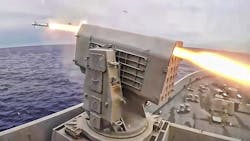Navy asks Raytheon to produce Rolling Airframe Missile (RAM) Block 2 for shipboard missile defense
RAM is a ship self-defense weapon designed to provide protection for ships of all sizes, ranging from 500-ton fast attack craft to 95,000-ton aircraft carriers. Friday's contract is for the RAM Block 2 guided missile round pack, missile ordnance alterations, and spare parts.
A supersonic, lightweight, quick-reaction, fire-and-forget weapon, the RAM system is designed to attack enemy helicopters, aircraft, and surface craft. It uses passive RF and infrared guidance for engaging several threats simultaneously.
RAM Block 2 has a large rocket motor, advanced control section, and an enhanced RF receiver able to detect quiet threat emitters. It is more maneuverable and longer range than its predecessors.
The MK 44 guided missile round pack and the MK 49 guided missile launching system together hold 21 missiles. Existing shipboard sensors can provide the system with target and pointing information.
The MK 44 missile also part of the SeaRAM anti-ship missile defense system, replacing the M601A1 Gatling gun in the Phalanx close-in weapon system with an 11-round launcher.
The Phalanx system’s sensor suite and internal combat management system reduces its dependence on the ship’s combat system and enables a fast reaction.
The RAM is an international cooperative program between the U.S. and Germany. Raytheon shares development, production and maintenance with the German companies LFK, DBD, and RAMSYS.
This contract, which has options that could increase its value to $529.8 million combines purchases for the Navy and the governments of Qatar, Egypt, and Turkey.
Raytheon and its partners will do the work in Ottobrunn, Germany; Tucson, Ariz.; Rocket Center, W.Va.; Dallas; Mason, Ohio; Glenrothes, Scotland; Cincinnati; Andover, Mass.; and other U.S. locations, and should be finished by September 2023.
For more information contact Raytheon Missile Systems online at www.raytheon.com, or Naval Sea Systems Command at www.navsea.navy.mil.
Ready to make a purchase? Search the Military & Aerospace Electronics Buyer's Guide for companies, new products, press releases, and videos
